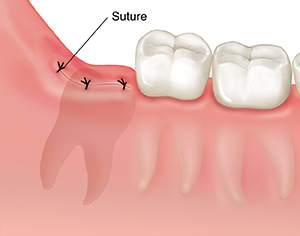Wisdom Teeth: Removal
Wisdom teeth are often removed (extracted) in a surgeon’s office or in an outpatient surgical center. Your experience depends on the position of the teeth, the number of teeth being removed, and other factors. Your surgeon may advise removing all of your wisdom teeth in a single visit, even if they are not all causing problems. Or they may advise separate visits for each side of the mouth.
Getting ready for surgery
Your surgeon can tell you how long the surgery is likely to take. Including recovery from anesthesia, it may last between 45 minutes and 2 hours. Before surgery, be sure to:
-
Ask your surgeon any questions you have about the procedure or recovery.
-
Arrange time off from work or school. You’ll need 1 day or more to rest and to heal.
-
Tell your surgeon about any health problems you have.
-
Tell your surgeon about prescription medicines, over-the-counter medicines, vitamins, herbs, or supplements you normally take. They may advise some medicine changes.
-
Follow all directions you're given for not eating or drinking before surgery.
-
Wear loose, comfortable clothing. Choose a shirt with short sleeves. This makes it easier to put in an IV (intravenous) line.
-
Arrange for a ride home. An adult family member or friend must drive you home after surgery. Don’t drive yourself, and don’t take public transportation. The person who drives you should wait in the reception area during surgery.
-
Tell your surgeon if you've had any allergies or bad reactions to pain medicines that they plan to prescribe. Following surgery you may need prescription pain medicine.
How your tooth may be removed
A tooth can be removed in different ways. Details of the procedure will depend on:
-
The position of the tooth.
-
If the tooth has broken through the gum (erupted).
-
How deeply the tooth is embedded in the bone (impacted).
-
How close the roots of the tooth are to the sinuses or certain nerves or blood vessels.
Removing the tooth
A cut (incision) may be made in the gum. This creates a flap of gum tissue that can be folded back to expose the bone and the tooth. In some cases, the surgeon may be able to loosen the tooth and remove it with forceps. The tooth may need to be cut into pieces (sectioned). Bone around the tooth may also need to be removed. In rare cases, only the crown of the tooth is removed (coronectomy). After the tooth has been removed, any incision that was made is closed with stitches.
 |
| The wisdom tooth is removed through an incision. The incision is closed with stitches (sutures). |
Types of anesthesia
The type of anesthesia you receive depends on your surgeon’s advice and your preference. Your insurance coverage may also be a factor. Tell your surgeon if you've had problems with anesthesia in the past. Types of anesthesia include:
-
Local anesthesia. This numbs only the area around the tooth to be removed. Local anesthesia is used even if another type of anesthesia is also given to you.
-
Sedative. This helps you stay relaxed but awake during surgery. Different levels of sedation are available, such as minimal, moderate, and deep. Nitrous oxide is 1 type of sedative. Other sedatives are given in pill form or by IV.
-
General anesthesia. This puts you to sleep during surgery. Your surgeon may advise using it if the removal is likely to be difficult. Or if you prefer to be asleep during the whole procedure.
Online Medical Reviewer:
Chris Southard RN
Online Medical Reviewer:
Marianne Fraser MSN RN
Online Medical Reviewer:
Melinda Murray Ratini DO
Date Last Reviewed:
3/1/2024
© 2000-2025 The StayWell Company, LLC. All rights reserved. This information is not intended as a substitute for professional medical care. Always follow your healthcare professional's instructions.